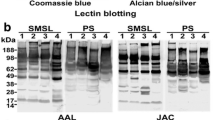Abstract
A molecular analysis of complement components (C3, C4, and factor B) in human saliva was performed by SDS-PAGE and immunoblotting. Complement C3 was detected as a molecule composed of a 115-kDa α-chain linked to a 70-kDa β chain by disulfide bonds, and C3 levels ranged from 0.52 to 15.0 /μg/ml (n = 15). C4 was detected as a triple-chain molecule (98-kDa α chain, 73-kDa β chain, and 33-kDa γ chain) linked by disulfide bonds, and C4 levels ranged from 0.086 to 4.8 μg/ml. Factor B was detected as a 100-kDa single chain, and factor B levels ranged from 0.042 to 0.62/μg/ml. The sizes and subunit structures of the complement components in human saliva were compatible with those reported in human serum. The results of a hemolytic assay indicated that the complement molecules in human saliva were functionally active. These complement components may participate in the local immune and inflammatory responses in the oral cavity.
Similar content being viewed by others
REFERENCES
Morgan BP: The complement system. In Complement: Clinical Aspects and Relevance to Disease, Morgan BP (ed). London, Academic Press, 1990, pp 1–35
Challacombe SJ, Shirlaw PJ: Immunology of diseases of the oral cavity. In Handbook of Mucosal Immunology, Ogra PL, Mestecky J, Lamm ME, Strober W, McGhee JR, Bienenstock J (eds). San Diego, Academic Press 1994, pp 607–624
Smith DJ, Taubman MA, King WF: Immunological features of minor salivary gland saliva. J Clin Immunol 7:449–455, 1897
Colten HR, Strunk RC: Synthesis of complement components in liver and at extrahepatic sites. In Complement in Health and Disease, Whaly K, Loos M, Weiler JM (eds). Dordrecht, Kluwer Academic, 1993, pp 127–158
Brooimans RA, Stegmann APA, van Dorp WT, van der Ark AAJ, van der Woude FJ, van ES LA, Daha MR: Interleukin 2 mediates stimulation of complement C3 biosynthesis in human proximal tubular epithelial cells. J Clin Invest 88:379–384, 1991
Strunk RC, Eidlen DM, Mason RJ: Pulmonary alveolar type II epithelial cells synthesize and secrete proteins of the classical and alternative complement pathways. J Clin Invest 81:1419–1426, 1988
Rothmann BL, Despins AW, Kreutzer DL: Cytokine regulation of C3 and C5 production by the human type II pneumocyte cell line, A549. J Immunol 145:592–598, 1990
Andoh A, Fujiyama Y, Bamba T, Hosoda S: Differential cytokine regulation of complement C3, C4, and factor B synthesis in human intestinal epithelial cell line, Caco-2. J Immunol 151:4239–4247, 1993
Andoh A, Fujiyama Y, Sumiyoshi K, Hodohara K, Okabe H, Ochi Y, Bamba T, Brown WR: Modulation of complement C3, C4, and factor B production in human intestinal epithelial cells: Differential effects of TNF-α, IFN-γ, and IL-4. Pathophysiology 2:251–259, 1995
Ahrenstedt O, Knutson L, Nilsson B, Nilsson-Ekdahl K, Odlind B, Hallgren R: Enhanced local production of complement components in the small intestines of patients with Crohn's disease. N Engl J Med 322:1345–1349, 1990
Andoh A, Fujiyama Y, Sumiyoshi K, Bamba T: Local secretion of complement C3 in the exocrine pancreas: Ductal epithelial cells as a possible biosynthetic site. Gastroenterology 110:1919–1925, 1996
Wirtz GH, Price RA, Mutchler BA, Miller RW: The first component of complement as a constituent of human salivary sediment. Arch Oral Biol 32:505–508, 1987
Hosni MM, Zenaib AS, Omaima LG: Serum and salivary C3a concentrations in human periodontitis. Egypt Dent J 35:231–244, 1989
Johnstone RW, Loveland BE, McKenzie IF: Identification and quantification of complement regulator CD46 on normal human tissues. Immunology 79:341–347, 1993
Schneiderman RD, Lint TF, Knight KL: Activation of the alternative pathway of complement by twelve different rabbit-mouse chimeric transfectoma IgA isotypes. J Immunol 145:233–237, 1990
Bogers WMJM, Stad RK, van ES LA, Daha MR: Immunoglobulin A: interaction with complement, phagocytic cells and endothelial cells. Complement Inflamm 8:347–358, 1991
Zhang W, Lachmann PJ: Glycosylation of IgA is required for optimal activation of alternative pathway by immune complexes. Immunology 81:137–141, 1994
Witte DP, Welch TR, Beischel LS: Detection and cellular localization of human C4 gene expression in the renal tubular epithelial cells and other extrahepatic epithelial sources. Am J Pathol 139:717–724, 1991
Laemmli UK: Cleavage of structure protein during the assembly of the head of bacteriophage T. Nature 227:680–685, 1970
Towbin H, Staehein T, Gordon J: Electrophoretic transfer of proteins from polyacrylamide gels to nitrocellulose sheets: Procedure and some applications. Proc Natl Acad Sci USA 76:4350–4354, 1979
Feason DT, Austen KF, Ruddy S: Formation of a hemolytically intermediate by the interaction between properdine factor B and D and activated third component of complement. J Exp Med 138:1305–1313, 1973
Author information
Authors and Affiliations
Rights and permissions
About this article
Cite this article
Andoh, A., Fujiyama, Y., Kimura, T. et al. Molecular Characterization of Complement Components (C3, C4, and Factor B) in Human Saliva. J Clin Immunol 17, 404–407 (1997). https://doi.org/10.1023/A:1027320425291
Issue Date:
DOI: https://doi.org/10.1023/A:1027320425291



